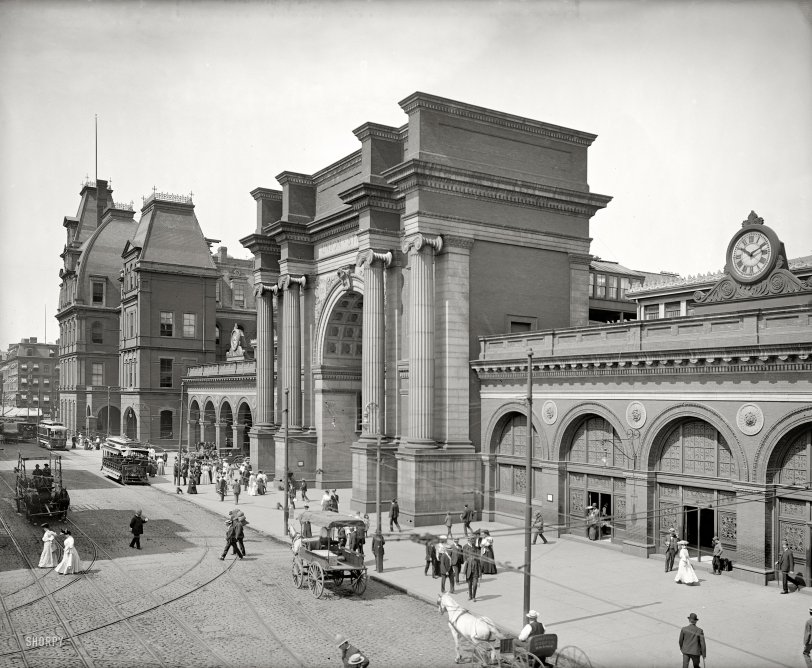


Framed or unframed, desk size to sofa size, printed by us in Arizona and Alabama since 2007. Explore now.
Shorpy is funded by you. Patreon contributors get an ad-free experience.
Learn more.

- Freeze Frame
- Texas Flyer wanted
- Just a Year Too Soon
- WWII -- Replacing men with women at the railroad crossing.
- Yes, Icing
- You kids drive me nuts!
- NOT An Easy Job
- I wonder
- Just add window boxes
- Icing Platform?
- Indiana Harbor Belt abides
- Freezing haze
- Corrections (for those who care)
- C&NW at Nelson
- Fallen Flags
- A dangerous job made worse
- Water Stop
- Passenger trains have right of way over freights?
- Coal
- Never ceases to amaze me.
- Still chuggin' (in model form)
- Great shot
- Westerly Breeze
- For the men, a trapeze
- Tickled
- Sense of loneliness ...
- 2 cents
- Charm City
- What an Outrage
- Brighton Park
Print Emporium
Union Station: 1905

Boston, Massachusetts, circa 1905. "North Station." An update of this view. 8x10 inch dry plate glass negative, Detroit Publishing Company. View full size.
Two Depots in One
The section at far left was once the Boston & Lowell RR depot. The center (North Union Station section) was an addition. A very LARGE addition! Far better then the buildings that replaced it all in later years.
Horses in the City
Even Paul Revere, a successful merchant, didn't bother keeping his own horse in the city. He borrowed Brown Beauty from John Larkin across the river in Charlestown. It must have been a lot like having a car in the city is now; unnecessary and too much trouble for most. Although I have seen the remains of what look like they may be horse stables in Richmond which are now used as sheds.
The Gahden
Future site of the Boston Garden (and present site of its replacement, the "TD Garden"), home of Cousy, Russell, Heinsohn, Havlicek, the Joneses, Cowens, Bird, DJ, Chief, McHale, The Big 3, et al. Not to mention Orr, Espo, Bucyk, Sanderson, and the rest of the Big Bad Bruins of the 1970's. North Station today still functions as the southern terminus of the North Shore commuter rail line, but the train station part of the building is essentially invisible from the street. Nothing like the Transportation Temple of yesteryear shown in the photograph. Regardless, Causeway Street is full of pedestrian traffic every day, and many nights, in much the same way as it was 105 years ago. One of those irreplaceable urban gathering places.
Can I use my Metro card?
Except for issues of infection, illness and a change of clothing, I think most modern city dwellers would fit into this scene nicely. How much for a street car ride?
Remember Mr Kane's friend Mr Bernstein's memory of the girl in the white dress? We old men remember the girls in white dresses. I'd tip my hat, too.
Horseback Riding
There are lots of old pictures of people astride usually in a big park with a bridle path. Generally only the wealthy could maintain a riding mount and riding was considered a pastime/sport. I'd love to see some pics of Durlands Riding Academy in Manhattan on here!
[They're already here! - Dave]
Re: No one rides no. 2
That's why I love this site and read all comments. Pondering all the photo details and anomalies makes us question our assumptions about how things were done in the past, and perhaps question present practices too. I enjoyed both the original question and the explication from Dr Q.
Nice to see a couple of polite men.
Even in a busy Boston street there are two men who acknowledge a lady passing.

Saddling Up
To Ride a Horse: first you have to keep the horse. In the city or town, this could well be at some livery stable at some distance away, unless you had a small estate. You have to feed and water the horse, shovel the manure, and clean the hooves daily, putting up with flies and bad smells all the while. And where shall we keep the hay and oats? To ride, we must bring out the horse, brush down, apply saddle blanket, get saddle, put on horse, pass girth underneath, lash up to saddle rings, pull tight, get the bridle on, retighten the girth, make sure the horse is reasonably happy with all this, and finally, mount. Reverse entire process when returning home. Horses were necessary in the country but smooth-running, clean electric transit was justifiably very popular in the city. Wagons of course were needed for hauling freight, and the rich could afford a carriage and driver.
Re: No One Rides
That made my day. You gotta wonder where people get their ideas about how people lived in olden times. Cowboy movies? "Little House on the Prairie"?
No One Rides
It is interesting to note that in so many of these old photos there are horse and wagons, yet no horseback riders. I wonder if there was some kind of special tax on horseback riding, because you don't even see hitching posts. I certainly would have ridden on a horse vs walking. Very strange indeed.
[All those streetcars you see in these pics -- they are for those 99 percent of city dwellers who didn't own a horse. - Dave]
























On Shorpy:
Today’s Top 5